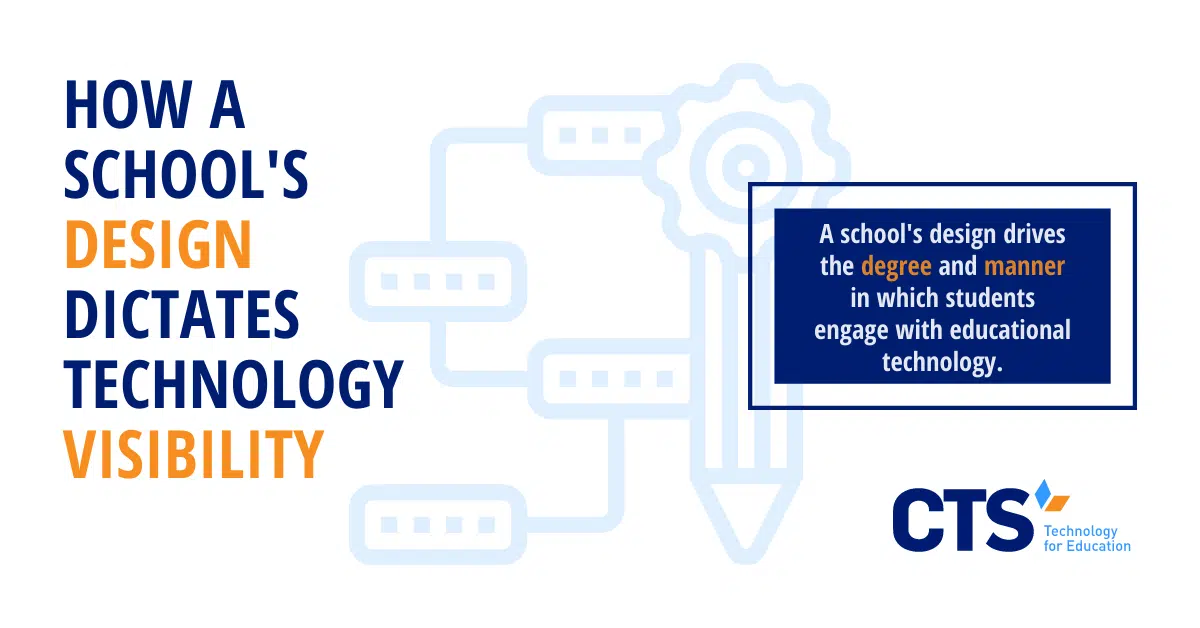A school’s design influences how and when teachers, students, and leaders use technology.
When a student’s family member walks into their school, they’ll likely encounter multiple examples of educational technology use. Students in one classroom may be using Chromebooks or Google Classroom to access instructional content, work on an essay, or engage with an online instructional platform. Teachers will likely use their classroom phones to call students’ families, a school administrator, or colleagues, while the school’s bell system signals the end of one class period or the end of a transition between classes. Each of these examples stems from the school’s unique instructional design. The degree to which technology operates–visibly and invisibly–derives from school administrators’ choices, all of which impact student achievement. A school’s unique design can, therefore, yield dramatically different uses of technology.
Almost all schools use technology to some extent. What do they share in common?
Of course, almost every school across the United States now uses technology to some extent. All schools need firewalls and other internet security software to keep their students’ personal data safe; most maintain some sort of internal telephone system, and projectors and teacher laptops (if not student devices) are commonplace across a diverse cross-section of schools.
At an even more basic level, almost all schools use email to communicate with students’ families. Whether a bi-weekly, family-facing newsletter detailing upcoming school events or a quick message from a teacher to a parent regarding their child’s academic performance, email is used across almost every school setting as a quick and accessible communication tool. Beyond these foundational similarities, however, the extent to which schools use technology (and whether it operates in the “background,” out of sight of teachers and students) can vary greatly depending on the school’s design.
Some school designs foreground “analog” learning. The technology is in the background.
In contrast to the trend in the broader educational technology sector, some schools embrace “analog” learning. They deemphasize teachers’ and students’ use of technology as a learning tool and instead relegate technology to the background. Sure, if you walked into one of these schools, you’d see at least some technology use. Still, there wouldn’t be Chromebook carts parked outside classrooms, SMART boards mounted on teacher’s whiteboards, or projectors displaying academic content. Instead, these schools would likely resemble images of a bygone era of schooling in which desks or small groups of students listened and wrote (by hand) as a teacher explained a particular concept.
While technology may not be visible in these schools, however, it nonetheless operates in the background. As described above, schools still need, at a minimum, security systems to protect any online student information they house and likely embrace at least some educational technology hardware, like telephones or teacher laptops. However, because of their “analog” design, these schools go against the grain in deemphasizing the regular use of technology in the classroom.
Other schools put technology at the center of their educational mission.
At the other end of the spectrum, some schools explicitly foreground the use of educational technology. For example, many schools emphasize their STEM offerings to prospective families and students. From robotics labs to 1:1 student-Chromebook ratios, these schools not only use but encourage students’ and teachers’ frequent use of educational technology.
Walk into one of these schools, and the emphasis on technology quickly becomes apparent: teachers project video content on screens for students’ viewing; students walk from class to class with their school-issued Chromebooks in hand, and administrators use iPads to record instructional content or take notes on teacher practice. Here, the school’s design drives teachers’, administrators’, and students’ technology use. And these schools’ explicit embrace of educational technology, in turn, impacts many key personnel, budgeting, and curricular decisions.
Other schools, likely the majority, are somewhere in between.
Of course, most schools aren’t at either end of the spectrum and instead use educational technology in certain contexts while foregoing it in others. In many cases, these “hybrid” schools look the way they do because of money: with scarce resources, they choose to prioritize technology use in some areas while deemphasizing it in others. When they look to scale their educational technology use across their school site or network, they’ll likely use the annual E-rate funding process to expand the impact of each dollar.
At CTS, we help schools use technology to accomplish their unique missions.
Our team has worked with more than 60 schools across the United States to use technology to accomplish their unique missions. We’re deeply ingrained in the work of our partner schools and collaborate with school leaders to make technology choices that align with each school’s instructional design. Contact us today to learn more about our services and how we can help your school accomplish its unique mission.




